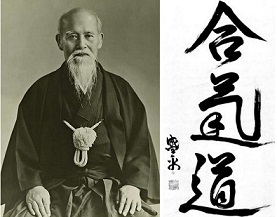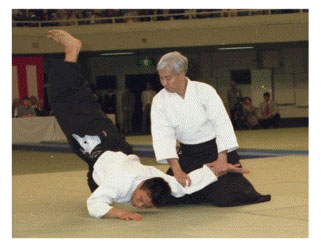History Aikido

Those who are not well informed about the true character of Aikido consider it to be nothing more than one of the old-fashioned martial arts. It is true that Morihei Ueshiba (1883-1969), the Founder of Aikido, studied many different kinds of traditional martial arts, and used that experience to formulate the techniques of Aikido. However, Aikido is far more than a composite of various martial arts. The Founder made that very clear: "Heretofore, I studied many kinds of martial art systems - Yagyu Ryu, Shinyo Ryu, Kito Ryu, Daito Ryu, Shinkage Ryu, and so on- but Aikido is not a composite of those arts: All Aiki techniques are a function of ki." Nevertheless, Aikido and Daito Ryu Aikijutsu are often confused even in Japanese reference works, and it is easy to understand why the general public cannot easily distinguish between the two arts. It is a fact that Morihei Ueshiba was once a disciple of Sokaku Takeda. (1859-1943), Grandmaster of the Daito Ryu, but when he was asked by a newspaper reporter if the creation of Aikido was a direct consequence of his training in the Daito Ryu, Morihei replied "No. It is more accurate to say that Master Sokaku opened my eyes to the true nature of Budo." The essential nature of Aikido is quite different from the other martial arts. The traditional martial arts of Japan can be considered important cultural and historical treasures, but after the Meiji Restoration in 1868, and the collapse of the old samurai order, the rapid and often indiscriminate westernization of the country had a deleterious effect on all the martial arts. Jigoro Kano (1860-1938) believed that the best elements of the Japanese martial arts should be preserved but it was very difficult for him to find and learn from accomplished masters-most of the old-time martial artists had disappeared. It was only through diligent and sustained effort that he was able to establish Kodokan Judo as a vehicle to preserve the best of the traditional Japanese martial arts in a modern context. Kano opened his first school in 1882, one year before Morihei Ueshiba was born. While Kano believed that introducing western style sports competition would help popularize his new art of Judo, Morihei followed a completely different path. So different in fact, that some people say, "Aikido is not really a martial art, is it?" Again, it is true that there are a number of poorly informed people who mistakenly view Aikido as some kind of health promoting exercise, a kind of dance, a form of martial mesmerism, or some such thing, and, as mentioned earlier, even reference works confuse Aikido and Aikijutsu. Let it be clear, however, that Aikido is Budo, a martial art. Aikido is a refinement of traditional martial techniques combined with an exalted, philosophy of the spirit. It is a method off forging mind and body. What is the exact nature of that philosophy of the spirit? To state it simply, it is the avoidance of the use of trickery, deception, or brute force to defeat an opponent. It is a vehicle to help us in our search for the Way, and it enables us to develop our individual character in a mutually satisfying manner with our training partners. In our search for the Way, we need to unify mind and body in order to harmonize ourselves with the natural order of the universe, and then respond freely to any contingency that may arise. Aikido is a training system that provides us the means to actually experience some overwhelmingly grand concept, but actually the universe of the Way of Aikido is very concrete and centered within one's own body. In Aikido training, we strive to understand the principles of ki through actual experience and employ various techniques to make those principles part of our everyday consciousness. This is one of the distinctive characteristics of Aikido. Let us look more closely at the nature of ki in Aikido in a concrete manner. When you see Aikido techniques performed, it is best to view all the movements as circular. When a circle is created, one's partner seems to spin off and fall of his own accord. Circular movements allow us to avoid collision with an opposing force, and facilitate harmonization. In order to create a true circle, there must be a firm center. A spinning top revolves at a high speed around a stable center, yet hardly appears to move at all. If you touch the top slightly, however, it will immediately fly off with a burst of centrifugal force, and its latent power becomes evident. The energy radiated by a, spinning top is a perfect example of "stillness within movement". The Founder often described the state of stillness within movement as sumikiri, "total clarity of mind and body." This concept lies at the very heart of Aikido. In 1924, the Founder accompanied the Omoto-kyo religious leader Onisaburo Deguchi (1871-1947) on a mission to Mongolia. On their way through the mountains, Onisaburo and his party were attacked by bandits. Bullets rained down on them from all sides. The martial artist Morihei, who was acting as Onisaburo's body- guard, thought that they were finished but then he suddenly felt extraordinarily calm and centered. He could sense the direction of the bullets and avoided being struck. The entire party escaped unscathed. The Founder later described that extraordinarily calm state as sumikiri, still- ness within movement, and said after that amazing experience he could immediately perceive any murderous or hostile intent that arose from any quarter. This Dliraculous episode is quite enticing but it must not be overlooked that the Founder's experience of sumikiri was due to his long years of daily intense training of the body and mind. It did not occur easily, with no effort. Without constant practice, understanding of the true nature of ki will never be attained. In the dojo, training follows certain rules. On the street, however, anything can happen, making it difficult for us to retain our equanimity. It is easy to maintain one's equanimity
under ideal circumstances; one of the goals of Aikido is to teach us how to maintain our equanimity regardless of the situation, no matter how harrowing or difficult. One method of keeping yourself centered is to breathe from the seika tanden (a psychophysical point about two inches below the navel). Remind yourself that the ki that animates your own body is the same ki that animates the entire universe. All the circular movements that you practice in Aikido are never contrary to the principles of nature. Control your breath and unite yourself with the natural rhythm of the universe. This is the way to keep centered in your seika tanden. Your own center must be linked to the center of the earth. Ki emanates from that sensation of stability and calm. Unlike many other martial art masters who tended to formulate elaborate rules and regulations for their training halls, Morihei disliked that practice and demanded only that his disciples follow their natural common sense.

However, as Aikido became more and more popular his senior students requested that he establish some kind of guideline for training. "Times have changed, it seems," Morihei responded with a smile and came up with "Precautions for Aikido Training." Aikido techniques can be instantly lethal so it is essential to observe the instructor's directions at all times and not engage in contests of strength. Aikido is an art in which "the one" is used to strike "the many." Train yourself to be mindful of attacks coming from four and eight directions. Always train in a vibrant and joyful manner. The instructor can only impart a small portion of the teaching. Only through ceaseless training can you obtain the necessary experience to bring these mysteries alive. In daily training, begin with basic movements to strengthen the body without overexertion. Warm up properly, and there will be no fear of injury, even for older people. Enjoy yourself while training and strive to comprehend its true purpose. The purpose of Aikido training is to forge the body and mind and to build one's character. The techniques are transmitted from person to person on an individual basis, and should not be disclosed indiscriminately to outsiders, nor used for evil purposes. These precautions are still quietly observed at the Headquarters Dojo, with the most emphasis being placed on number three, "Always train in a vibrant and joyful manner." At the mention of the term "martial art," many people conjure up an image of a person with an intimidating, aggressive demeanor, and indeed there are some so-called martial artists who act like that. However, such demeanor is a clear indication that one does not really under- stand Budo. Excessive aggression is really a vain boast masking a lack of self-confidence. One who truly understands Budo is, on the contrary, quite calm in appearance and gentle in demeanor. He or she is confident enough not to try to intimidate other human beings, and typically ha$ a happy expression on his or her face. To put it simply, they manifest shizen tai, a perfectly natural and relaxed state of being. In order to help them understand this kind of natural elation, I often say to the trainees, "Shouldn't we train in a joyful manner?" We cherish those trainees who really under- stand the heart of Aikido. Such trainees come to the dojo in high spirits, take pleasure in throwing and being thrown, work up a good sweat, and depart in high spirits. They are not interested in seeking a high rank-they simply delight in the joy of training. They manifest shizen tai, a completely natural state of being. The earth was born from the universe and those who flourish in that life-giving environment can directly become one with nature. They never oppose natural law, and never try to control things through force. Such people manifest a natural and matter-of-fact equanimity. Such an attitude, based on deep experience, can be a great plus in a variety of social activities. If you train in a natural, fulfilling manner, with equanimity and a solid center, a tremendous amount of ki power will be generated. That will be of great benefit to both oneself and society. This is our natural, ideal form. To achieve that state of being is of far greater value than victory in some trifling contest. The purpose of Aikido is to make human beings strong by tapping their natural energy. This will also make them healthy in mind and body. In Aikido, we transcend the distinction between mind and body; we unify body and mind and function as a single entity. It is from the center of that unified entity that limitless ki is born, and vital breath springs forth. If those powerful forces are manifested in daily life, one can lead the best and most positive kind of existence. Ki power that emerges naturally and directly enables us daily to experience the joy, power, freedom, and flexibility of existence. Living vibrantly with true vigour, we can meet any challenge and accommodate ourselves to any contingency. The practice of Aikido can make this all possible, and this emphasis on harmonization and accommodation accounts for its worldwide popularity.
This text is a translation from the introduction of the book: Best Aikido - The Foundmentals των Kisshomaru Ueshiba, Moriteru Ueshiba, published by Kodansha International.
This text is a translation from the introduction of the book: Best Aikido - The Foundmentals των Kisshomaru Ueshiba, Moriteru Ueshiba, published by Kodansha International.


